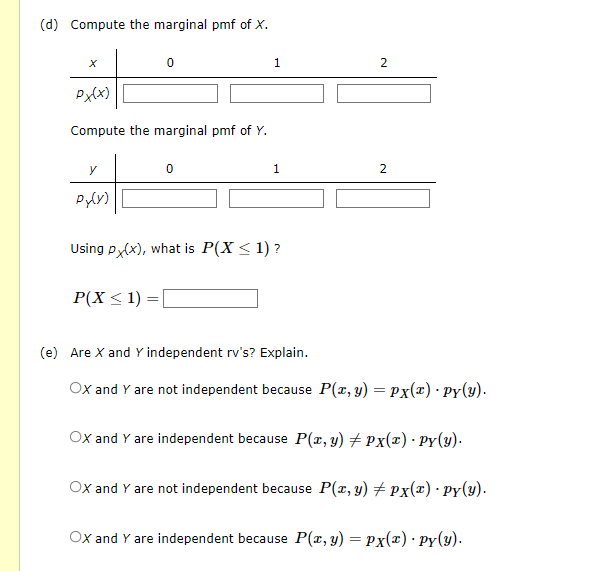(d) Compute the marginal pmf of X. Px(x) Compute the marginal pmf of Y. Py(V) 0 P(X ≤ 1) = | 0 1 1 Using px(x), what is P(X < 1)? 2 2 (e) Are X and Y independent rv's? Explain. OX and Y are not independent because P(x, y) = px(x) · py(y). OX and Y are independent because P(x, y) = Px(x) · Py(y). OX and Y are not independent because P(x, y) ‡ px(x) · py(y). OX and Y are independent because P(x, y) = px(x) · Py(y).
(d) Compute the marginal pmf of X. Px(x) Compute the marginal pmf of Y. Py(V) 0 P(X ≤ 1) = | 0 1 1 Using px(x), what is P(X < 1)? 2 2 (e) Are X and Y independent rv's? Explain. OX and Y are not independent because P(x, y) = px(x) · py(y). OX and Y are independent because P(x, y) = Px(x) · Py(y). OX and Y are not independent because P(x, y) ‡ px(x) · py(y). OX and Y are independent because P(x, y) = px(x) · Py(y).
A First Course in Probability (10th Edition)
10th Edition
ISBN:9780134753119
Author:Sheldon Ross
Publisher:Sheldon Ross
Chapter1: Combinatorial Analysis
Section: Chapter Questions
Problem 1.1P: a. How many different 7-place license plates are possible if the first 2 places are for letters and...
Related questions
Question
Answer D, E
| y | ||||
|
p(x,y)
|
0 | 1 | 2 | |
| x | 0 | 0.10 | 0.03 | 0.02 |
| 1 | 0.06 | 0.20 | 0.07 | |
| 2 | 0.05 | 0.14 | 0.33 |

Transcribed Image Text:(d) Compute the marginal pmf of X.
X
Px(x)
Compute the marginal pmf of Y.
y
Py(y)
0
P(X ≤ 1):
=
0
1
Using px(x), what is P(X < 1)?
1
2
2
(e) Are X and Y independent rv's? Explain.
OX and Y are not independent because P(x, y) = Px(x) · py(y).
OX and Y are independent because P(x, y) = Px(x) · Py(y).
OX and Y are not independent because P(x, y) #px(x). Py(y).
OX and Y are independent because P(x, y) = px(x) · py(y).
Expert Solution
This question has been solved!
Explore an expertly crafted, step-by-step solution for a thorough understanding of key concepts.
Step by step
Solved in 3 steps

Recommended textbooks for you

A First Course in Probability (10th Edition)
Probability
ISBN:
9780134753119
Author:
Sheldon Ross
Publisher:
PEARSON


A First Course in Probability (10th Edition)
Probability
ISBN:
9780134753119
Author:
Sheldon Ross
Publisher:
PEARSON
